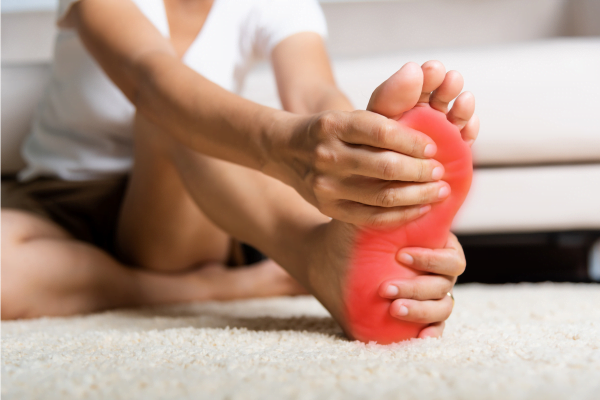Picture this: you’re enjoying a walk and feeling great. But then, you stub your toe. No big deal, right? Except for someone with diabetes, a seemingly minor bump can turn into a major problem – a diabetic foot ulcer. These open sores can be sneaky, developing painlessly at first, but if left unchecked, they can lead to infection and even amputation.
Don’t panic! This guide is your lifeline to healthy feet. We’ll unveil the secrets of diabetic foot ulcers, from what causes them to how to spot the early warning signs.
What are Diabetic Foot Ulcers?
A diabetic foot ulcer refers to a type of open sore or wound that often forms on the underside of the foot or in the toe area of individuals diagnosed with diabetes. These ulcers can be quite serious, and unfortunately, they’re fairly common.
Diabetic foot infections, like ulcers, can vary in severity, from surface-level sores to deep wounds that extend to the bone. They are considered serious due to their potential to become infected and lead to complications such as cellulitis, osteomyelitis, or even amputation if left untreated.
Causes of Diabetic Foot Ulcers
So, what exactly turns a bump into a full-blown ulcer? There are a few different culprits at play:
Nerve Damage (Neuropathy)
Here’s the thing about diabetic foot ulcers: they can be sneaky. How? Diabetes can harm and damage the nerves in your feet, making it harder to feel pain or even notice a small injury. This can lead to you accidentally injuring your foot without realizing it, and without proper care, that injury can turn into an ulcer.
Poor Circulation (Peripheral Arterial Disease)
High blood glucose levels can gradually damage your blood vessels, leading to a serious condition known as peripheral arterial disease (PAD). PAD reduces blood flow to the extremities, including the feet. When circulation is compromised, essential nutrients and oxygen have difficulty reaching the tissues in the feet, impairing the body’s ability to heal wounds effectively.
Foot Deformities
Over time, diabetes can trigger changes in the shape of your feet. Repeated trauma or pressure on specific areas of the foot can lead to deformities such as hammertoes, bunions, or Charcot’s foot. Such deformities change how weight and pressure are distributed across the foot, creating regions of increased stress that are susceptible to ulcer formation.
Ill-fitting Footwear
Wearing inappropriate footwear is a significant risk factor for developing diabetic foot ulcers. Tighter shoes can compress the foot, resulting in friction, diabetes blisters on feet, and calluses. On the other hand, excessively loose shoes may permit the foot to slide and rub against the interior, resulting in irritation and skin breakdown.
Early Warning Signs of Foot Ulcers
Now that you know the enemies, let’s learn how to identify them early on. Here are some warning signs of a diabetic foot ulcer to watch out for:
- Changes in skin appearance: This could include redness, dryness, or a change in color.
- Swelling, redness, or warmth: These can all be signs of infection or inflammation
- Drainage or pus: Any fluid leaking from a wound or a thick, yellowish, or greenish fluid that forms at the site of infection
- Any new foot pain (even mild): Remember, nerve damage can make it hard to feel pain, so even a slight discomfort shouldn’t be ignored.
Preventing Diabetic Foot Ulcers
Fortunately, diabetic foot ulcers can be largely prevented! Here are some steps you can take to keep your feet healthy and happy:
Daily Foot Inspections
Develop a daily habit of thoroughly examining your feet for any signs of injury, changes in skin color or texture, or swelling. Early detection of abnormalities allows for prompt intervention and prevents potential complications.
Proper Foot Hygiene
Ensure proper foot hygiene by washing your feet daily with warm water and mild soap. Pay particular attention to cleaning between the toes and drying your feet thoroughly afterward to prevent moisture buildup, which can result in fungal infections.
Moisturize Dry Skin
Dry, cracked skin is more susceptible to injuries and infections. Apply a moisturizer regularly to keep your feet soft and hydrated, focusing on areas prone to dryness, such as the heels and soles.
Choose Comfortable, Well-fitting Shoes
Ensure you invest in shoes that fit well and offer sufficient support. Opt for styles with a wide toe box to prevent crowding and friction, and avoid shoes that are too tight or too loose, as they can cause pressure points and skin irritation.
Inspect Your Shoes
Regularly inspect your shoes for any signs of wear and tear, rough seams, or foreign objects that could cause irritation or injury to your feet. Replace worn-out shoes promptly to maintain proper support and protection.
Managing Blood Sugar Levels
Keeping your blood sugar levels normal is essential for overall health and promotes optimal healing. Follow your healthcare provider’s recommendations for diabetes management, including medication, diet, exercise, and regular monitoring of blood glucose levels.
Foot Care Tips and Resources
Maintaining proper foot care is a crucial aspect of effectively managing diabetes. Here are some additional tips to help you keep your feet healthy:
- Regular doctor visits: It’s crucial to prioritize regular checkups with your doctor to have your feet examined, especially if you are at risk of diabetic foot ulcers. Your healthcare provider can assess your foot health, determine any potential issues early on, and provide directives on preventive approaches tailored to your needs, including diabetic foot ulcer treatment if necessary.
- Diabetic socks: Consider wearing specially designed diabetic socks to help protect your feet. These socks are crafted with soft, non-binding materials and feature seamless designs to reduce the risk of friction and pressure points, which can result in foot ulcers and other complications.
By incorporating these additional tips into your diabetes foot care routine and maintaining open communication with your healthcare provider, you can efficiently manage your condition and reduce the risk of developing foot-related complications. Prioritizing foot health is essential for maintaining overall well-being and quality of life.
Doctor’s Recommendation
To prevent diabetic foot ulcers, follow these simple steps:
- Daily Foot Checks: Look at your feet every day for any changes in skin color, texture, or wounds.
- Keep Feet Clean and Dry: Wash and dry your feet thoroughly, especially between the toes, to prevent fungal infections.
- Moisturize: Regularly moisturize your feet to prevent dry, cracked skin.
- Choose Proper Footwear: Wear well-fitting shoes with good support and a wide toe box to reduce pressure and friction.
- Manage Blood Sugar: Keep your blood sugar levels stable with medication, diet, exercise, and regular monitoring.
- Regular Doctor Visits: Have your feet checked by a healthcare provider regularly, especially if you notice any issues.
By following these steps, you can reduce the risk of diabetic foot ulcers and stay healthy.



